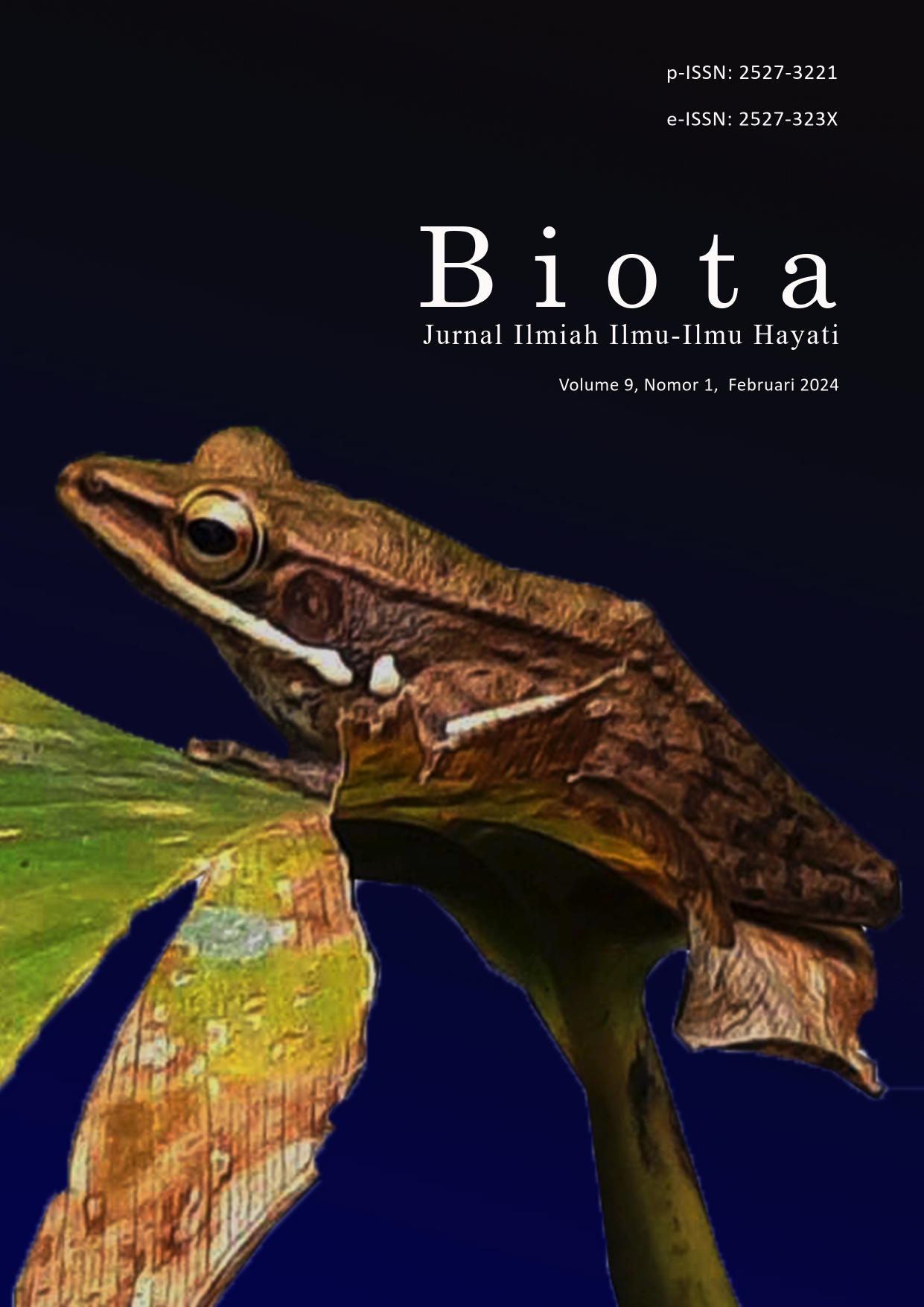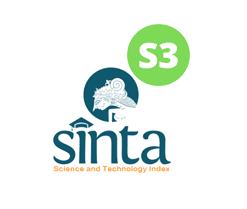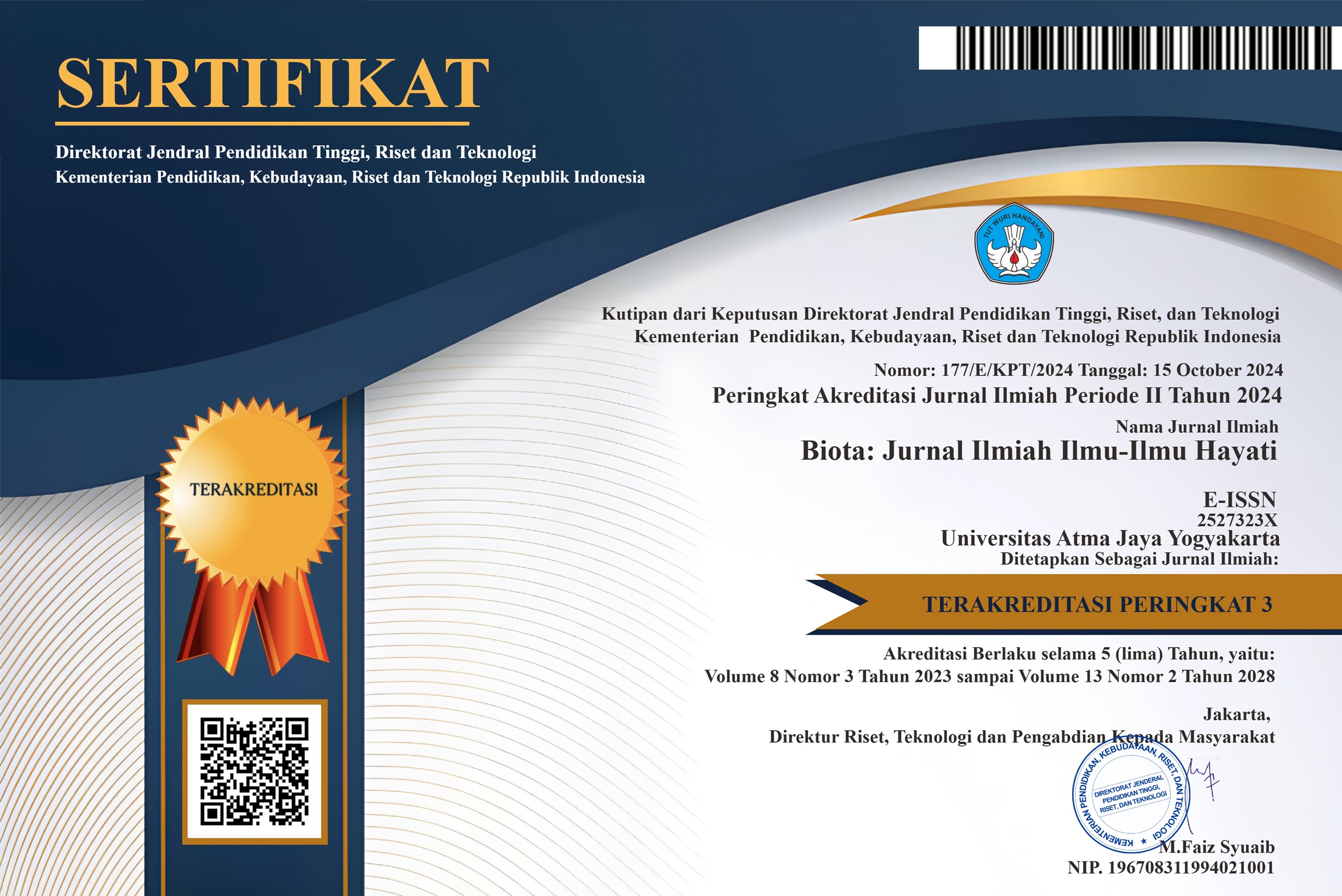Sinergisme Pertumbuhan dan Tingkat Kesukaan pada Pembuatan Tempe Probiotik dengan Penambahan Pichia kudriavzevii TMT-2 dan Lactobacillus plantarum Dad-13
DOI:
https://doi.org/10.24002/biota.v9i1.8181Keywords:
bakteri probiotik, khamir probiotik, Lactobacillus plantarum Dad-13, Pichia kudriavzevii TMT-2, tempe probiotikAbstract
Tempe probiotik dapat dibuat dengan penambahan khamir probiotik (Pichia kudriavzevii TMT-2) dan bakteri asam laktat (Lactobacillus plantarum Dad-13). Penelitian ini bertujuan untuk mempelajari sinergisme pertumbuhan antara jamur tempe, khamir dan bakteri probiotik, serta menentukan tempe probiotik yang disukai oleh panelis. Penelitian ini dikerjakan dengan menggunakan rancangan acak lengkap dua faktor, yaitu faktor pertama ialah jenis inokulum (tempe jamur merk Raprima, Raprima + Pichia kudriavzevii TMT-2, Raprima + L. plantarum Dad-13, Raprima + P. kudriavzevii TMT-2 + L. plantarum Dad-13. Faktor kedua adalah lama fermentasi (0, 24, 48, dan 72 jam). Hasil penelitian menunjukkan penambahan yeast, bakteri, dan dan bakteri probiotik tidak menghambat pertumbuhan jamur tempe. Penambahan khamir probiotik mempercepat laju pertumbuhan jamur tempe. Khamir dan bakteri probiotik yang ditambahkan dapat tumbuh dengan baik dan dapat mencapai 9 log10 CFU/g pada akhir fermentasi. Penambahan khamir dan bakteri probiotik tidak menurunkan tingkat kesukaan panelis dibandingkan dengan kontrol (jamur tempe). Berdasarkan jumlah probiotik dan tigkat kesukaan panelis perlakuan terbaik adalah tempe yang diinokulasi dengan Raprima + P. kudriavzevii TMT-2 + L. plantarum Dad-13. Tempe tersebut mengandung jumlah jamur sebanyak 8,53 log10 CFU/g, khamir 9,06 log10 CFU/g, dan bakteri 8,88 log10 CFU/g. Tempe probiotik ini layak untuk dikembangkan khususnya diversifikasi produk olahannya dan tingkat kesukaan konsumen.
References
Adams, M.R. & Nouts, M.JR. (2001). Fermentation and Food Safety. An Aspen Publication.
Badan Standarisasi Nasional. 2015. Tempe Kedelai. SNI 3144:2015. Jakarta.
Damayanti, E., Shabrina, N., Prihantoro, F.A. & Shoviri, M. (2021). Antifungal activities of lactic acid bacteria and yeast isolated from various types of Tempe Antifungal activities of lactic acid bacteria and yeast isolated from various types of Tempe. IOP Conference Series Materials Science and Engineering 1011(1): 012021
Datta, S., Timson, D. J. & Annapure, U. S. (2017). Antioxidant properties and global metabolite screening of the probiotic yeast. J Sci Food Agric 97(9): 3039-3049.
Owens, D.J. (2015). Indigenous Fermented Foods of Southeast Asia. CRC Press. Boca Raton.
Efriwati, Suwanto, A., Rahayu, G. & Nuraida, L. (2013). Population Dynamics of Yeasts and Lactic Acid Bacteria ( LAB ) During Tempeh Production. HAYATI Journal of Biosciences 20(2): 57–64.
Garcia-rubio, R., Oliveira, H. C. De, Rivera, J., Niño-vega, G. A., & Hall, R. A. (2020). The Fungal Cell Wall : Candida , Cryptococcus , and Aspergillus Species. Frontiers in Microbiology 10: 1–13.
Jaehrig, S.C., Rohn, S., Kroh, L.W., Fleischer, L.G. & Kurz ,T. (2007). In vitro potential antioxidant activity of (1→3),(1→6)-beta-
D-glucan and protein fractions from Saccharomyces cerevisiae cell walls. J. Agric. Food Chem 55: 4710–4716.
Kassaa, I. A. L. (2017). Methods and Techniques to Evaluate the Antiviral Activity of a New Probiotic Strain. In: New Insights on Antiviral Probiotics from Research to Applications (I.A. Kassaa, ed., 2017). Springer International Publishing AG Switzerland 1(1): 1-25.
Kustyawati, M.E., Nawansih, O. & Nurdjanah, S. (2017). Profile of aroma compounds and acceptability of modified tempeh. International Food Research Journal 24(2): 734-740.
Meidistria, T., Sembiring, L., Rahayu, E. S., Haedar, N., & Dwyana, Z. (2020). Survival of Lactobacillus plantarum dad 13 in probiotic cheese making. IOP Conference Series Materials Science and Engineering 575(2020): 012020.
Nurrahman, N., Astuti, M., Suparmo, S., Soesatyo, M. H. N. E. (2012). Pertumbuhan Jamur, Sifat Organoleptik, dan Aktivitas Antioksdian Tempe Kedelai Hitam yang Diproduksi dengan Berbagai Jenis Inokulum. Agritech 32(1): 60–65.
Nursiwi, A, Sekar, A., Supriyanto, Rahayu, S. E. (2018). Development of the Traditional Tape Ketan into Probiotic Drink with the Supplementation of Lactic Acid Bacteria. Indonesian Food and Nutrition Progress 15(1): 11–20.
P3FNI. (2017). Apa Itu Pangan Fungsional?P3FNI. https://p3fni.org/.
Pabesak, RV., Lusiawati Dewi, L. & Lestario, L. (2013). Aktivitas Antioksidan dan Fenolik Total Pada Tempe Dengan Penambahan Biji Labu Kuning (Cucurbita moschata ex Poir). Prosiding Seminar Nasional X Pendidikan Biologi FKIP UNS. Solo.
Pamungkaningtyas, F. H., Kamil, R. Z. & Setyawan, R. H. (2018). Sensory Evaluation of Yogurt-like Set and Yogurt-like Drink Produced by Indigenous Probiotic Strains for Market Test. Indonesian Food and Nutrition Progress 15(1): 1-10.
Pengkumsri, N., Sivamaruthi, B. S., Sirilun, S., & Peerajan, S. (2016). Extraction of β -glucan from Saccharomyces cerevisiae : Comparison of different extraction methods and in Vivo assessment of immunomodulatory effect in mice. Food Science and Technology 37(1): 124-130.
Purwandhani, S. N., Utami, T., Millati, R., & Rahayu, E. S. (2017). Potency of Lactobacillus plantarum Isolated from Dadih to Increase the Folate Levels in Fermented Milk. Agritech 37(4): 395–401.
Purwijantiningsih, E., Dewanti-hariyadi, R., & Nurwitri, C. C. (2005). Penghambatan Produksi Aflatoksin dari Aspergillus flavus oleh Kapang dan Khamir yang Diisolasi dari Ragi Tempe. Biota X (3): 146-153.
Rahayu, E.S. and Utami, T. (2019). Probiotik dan Gut Microbiota serta Manfaatnya pada Kesehatan. PT Kanisius. Yogyakarta.
Rahayu, E. S., Mariyatun, M., Manurung, N. E. P., Hasan, P. N., Therdtatha, P., Mishima, R., Komalasari, H., Mahfuzah, N. A., Pamungkaningtyas, F. H., Yoga, W. K., Nurfiana, D. A., Liwan, S. Y., Juffrie, M., Nugroho, A. E., & Utami, T. (2021). Effect of probiotic Lactobacillus plantarum Dad-13 powder consumption on the gut microbiota and intestinal health of overweight adults. World Journal of Gastroenterology 126(1): 107–128.
Sheih, I., Fang, T. J., Wu, T., & Chen, R. (2014). Effects of fermentation on antioxidant properties and phytochemical composition of soy germ. J Sci Food Agric 94: 3163–3170.
Sulistiani. 2017. Senyawa Antibakteri yang Diproduksi oleh Lactobacillus plantarum dan Aplikasinya untuk Pengawetan Bahan Ikan. Jurnal Biologi Indonesia 13(2): 233-240.
Steinkraus, K. (2004). Traditional fermentations as industrial resources. Acta Biotecnol 3: 1–12.
Tari, A.I.N, Handayani,C.B., Sudarmi. 2016. Potensi probiotik indigenus Lactobacillus plantarum dad 13 pada yogurt dengan suplementasi ekstrak ubi jalar ungu untuk penurun diare dan radikal bebas. Agritech 36 (1): 7-14.
Utaminingdyah, AB, Yulianto, WA, Pujimulyani, D. (2022). Pengaruh Jenis Beras dan Konsentrasi Karboksimetil Selulosa ( CMC ) terhadap Tape Beras Probiotik dan Produk Es Krim. Agritech 42(2): 165–176.
Virgianti, D. P. (2015). Uji Antagonis Jamur Tempe ( Rhizopus sp ) terhadap Bakteri Patogen Enterik. Biosfera 32 (3): 162-168.
WHO/FAO. (2006). Probiotics in food. In Probiotics in food Health and nutritional properties and guidelines for evaluation. World Health Organization, Food and Agriculture Organiz
Nations.
Widoyo, S., & Handajani, S. R. I. (2015). Pengaruh lama fermentasi terhadap kadar serat kasar dan aktivitas antioksidan tempe beberapa varietas kedelai. Biofarmasi 13(2): 59–65.
Winiati, PR, Rindit, P., Santoso, U. & Nuraida, L., A. (2015). Tinjauan Ilmiah Proses Pengolahan Tempe Kedelai. Perhimpunan Ahli Teknologi Pangan Indonesia (PATPI).
Wulandari, W, Yulianto, W.A. & Pujimulyani, D. (2023). Probiotic potential of the Indonesian local variety of fermented parboiled rice. Food Research 7(2): 96 - 106.
Yang, E. J., & Chang, H. C. (2010). Purification of a new antifungal compound produced by Lactobacillus plantarum AF1 isolated from kimchi. International journal of food microbiology 139(1-2): 56–63.
Yulianto, W.A., Pujimulyani, D., Pratami, C.A. (2022). The Potential of Glutinous Rice Tape Added with Lactobacillus plantarum Dad-13 And Saccharomyces boulardii. J. Functional Food & Nutraceutical 4(1): 57-66.
Yulianto, W.A. (2023). Evaluasi Keamanan dari Isolat Yeast Probiotik Dari Sayur-Sayuran dan Buah-Buahan [Laporan Penelitian Payung]. Universitas Mercu Buana. Yogyakarta.
Yulianto, W.A. & Pujimulyani, D. (2022). Isolasi dan Karakterisasi Potensi Yeast Probiotik Dari Berbagai Sumber [Laporan Penelitian Payung]. Universitas Mercu Buana. Yogyakarta.
Downloads
Published
How to Cite
Issue
Section
License
Copyright (c) 2024 Muhammad Raihan Yafi , Wisnu Adi Yulianto

This work is licensed under a Creative Commons Attribution-NonCommercial 4.0 International License.
Authors who publish with Biota : Jurnal Ilmiah Ilmu-Ilmu Hayati agree to the following terms:
- Authors retain copyright and grant the Biota : Jurnal Ilmiah Ilmu-Ilmu Hayati right of first publication. Licensed under a Creative Commons Attribution-NonCommercial 4.0 International License that allows others to share the work with an acknowledgment of the work's authorship and initial publication in this journal.
- Authors are able to enter into separate, additional contractual arrangements for the non-exclusive distribution of the journal's published version of the work (e.g., post it to an institutional repository or publish it in a book), with an acknowledgment of its initial publication in Biota : Jurnal Ilmiah Ilmu-Ilmu Hayati, and as long as Author is not used for commercial purposes.













